CHEVROLET TRACKER 1993 Owners Manual
Manufacturer: CHEVROLET, Model Year: 1993, Model line: TRACKER, Model: CHEVROLET TRACKER 1993Pages: 339, PDF Size: 15.75 MB
Page 201 of 339
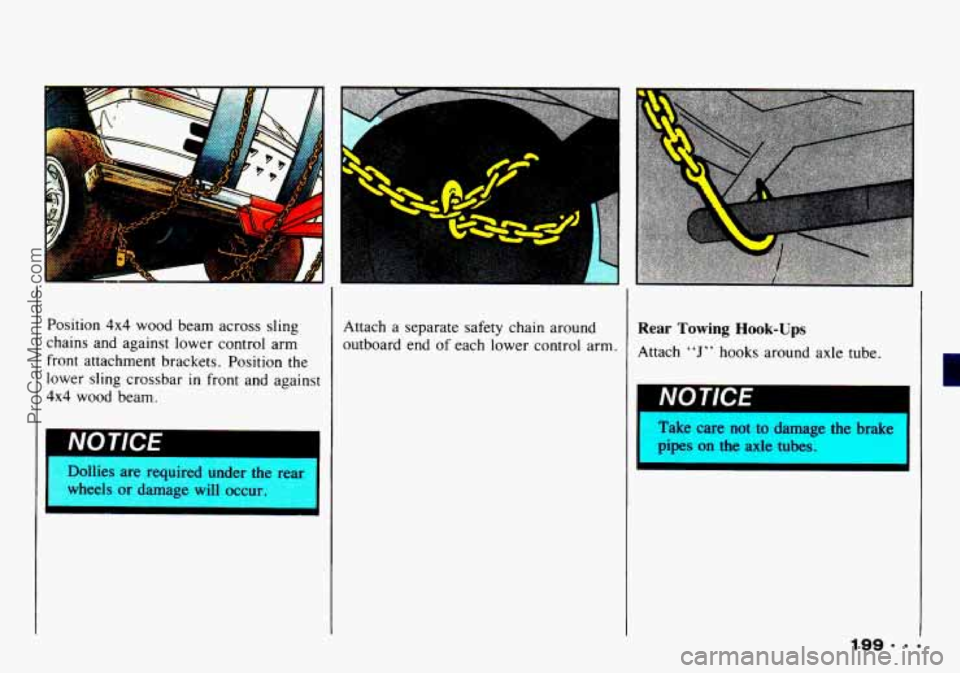
Position 4x4 wood beam across sling
chains and against lower control arm
front attachment brackets. Position the
lower sling crossbar
in front and against
4x4 wood beam. Attach a separate safety chain around
outboard end
of each lower
control arm.
Rear Towing Hook-Ups
Attach “J” hooks around axle tube.
I Take care not to damage the brake I
pipes on the axle tubes. 1
ProCarManuals.com
Page 202 of 339
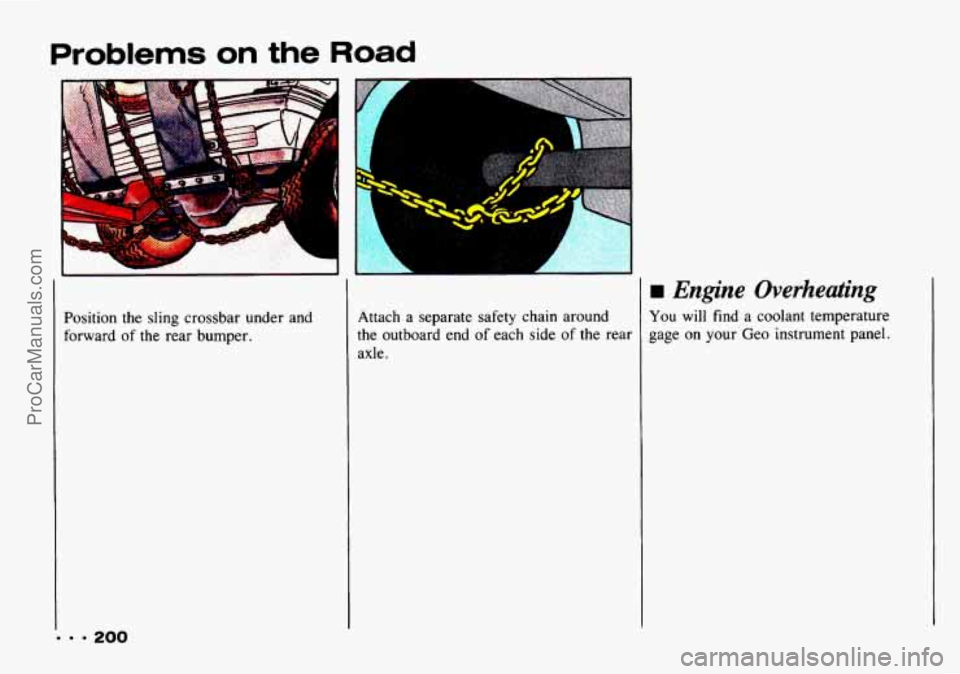
Problems on the Road
Position the sling crossbar under and
forward
of the rear bumper.
. = = 200
A L
Attach a separate safety chain around
the outboard end of each side of the rear
axle.
H Engine Overheating
You will find a coolant temperature
gage on your Geo instrument panel.
ProCarManuals.com
Page 203 of 339
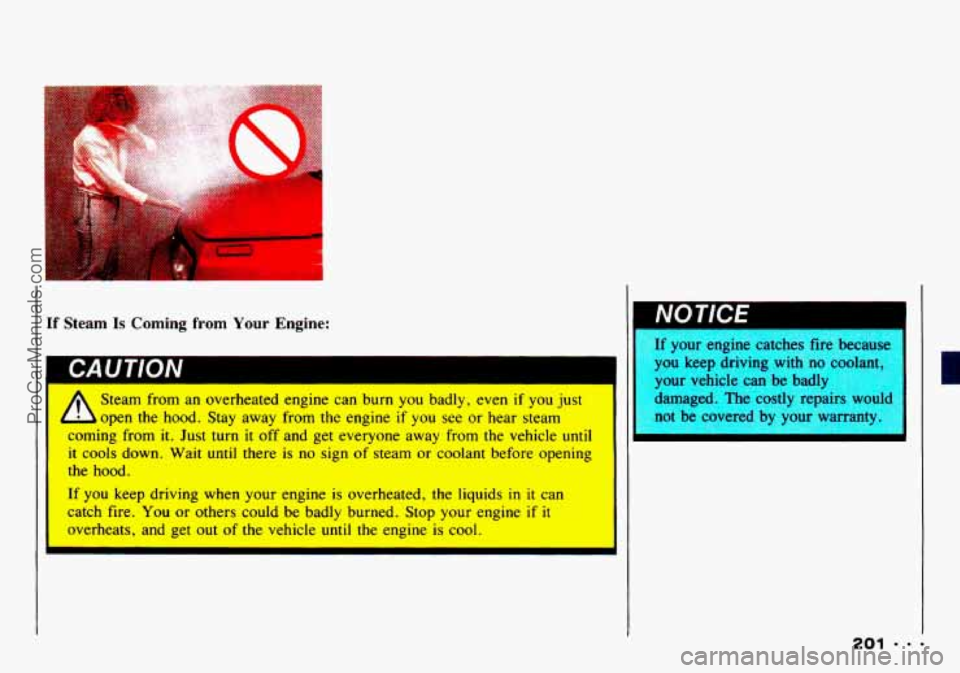
If Steam Is Coming from Your Engine:
' Steam from an overheated engine can burn you badly, even if you just
-open the hood. Stay away from
the engine if you see or hear steam
coming from it. Just turn it
off and get everyone away from the vehicle until I
it cools down. Wait until there is no sign of steam or coolant before opening
the hood.
If
you keep driving when your engine is overheated, the liquids in it can
catch
fire. You or others could be badly burned. Stop your engine if it
overheats, and get out of the vehicle until the engine is cool.
If your engine catches fire becaw-
II
IOU keep driving with no coolant,
four vehicle can be badly
imaged. The costly repairs
wou
aot be covered by your warranty.
ProCarManuals.com
Page 204 of 339
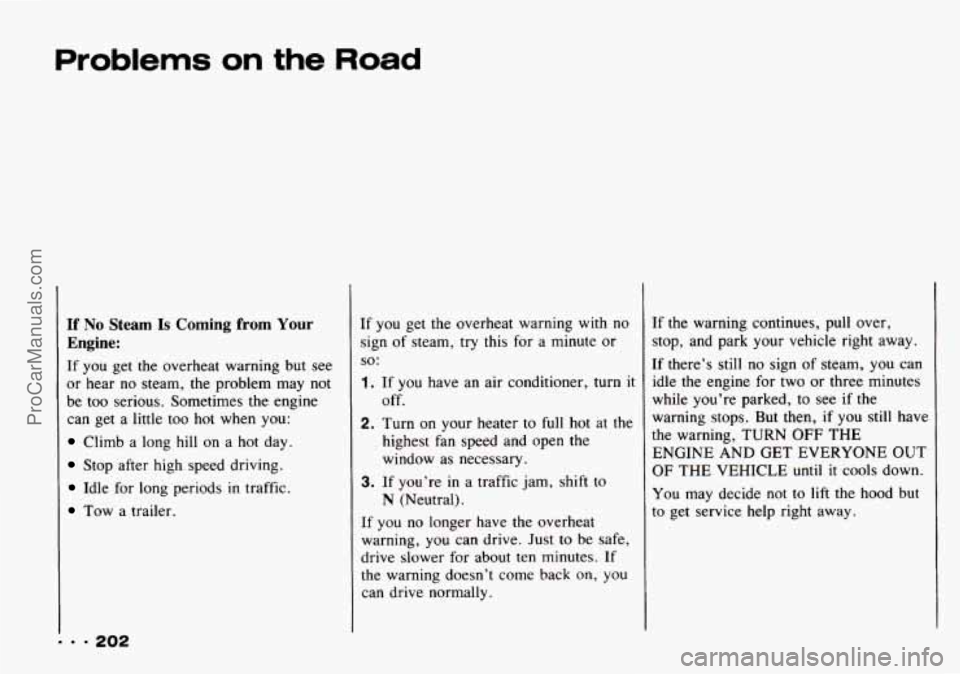
Problems on the Road
... 202
If No Steam Is Coming from Your
Engine:
If you get the overheat warning but see
or hear no steam,
the problem may not
be too serious. Sometimes the engine
can get a little too hot when you:
Climb a long hill on a hot day.
Stop after high speed driving.
Idle for long periods in traffic.
Tow a trailer. If you
get the overheat warning with no
sign of steam, try this for
a minute or
1. If you have an air conditioner, turn it
2. Turn on your heater to full hot at the
so:
off.
highest fan speed and open
the
window as necessary.
3. If you’re in a traffic jam, shift to
N (Neutral).
If
you no longer have the overheat
warning, you can drive. Just to be safe,
drive slower for about ten minutes. If
the warning doesn’t come back on, you
can drive normally.
If the warning continues, pull over,
stop, and park your vehicle right away.
If there’s still no sign of steam, you can
idle the engine for two
or three minutes
while you’re parked, to see if the
warning stops. But then, if you still have
the warning, TURN OFF THE
ENGINE AND GET EVERYONE OUT
OF THE VEHICLE until it cools down.
You may decide not to lift the hood but
to get service help right away.
ProCarManuals.com
Page 205 of 339
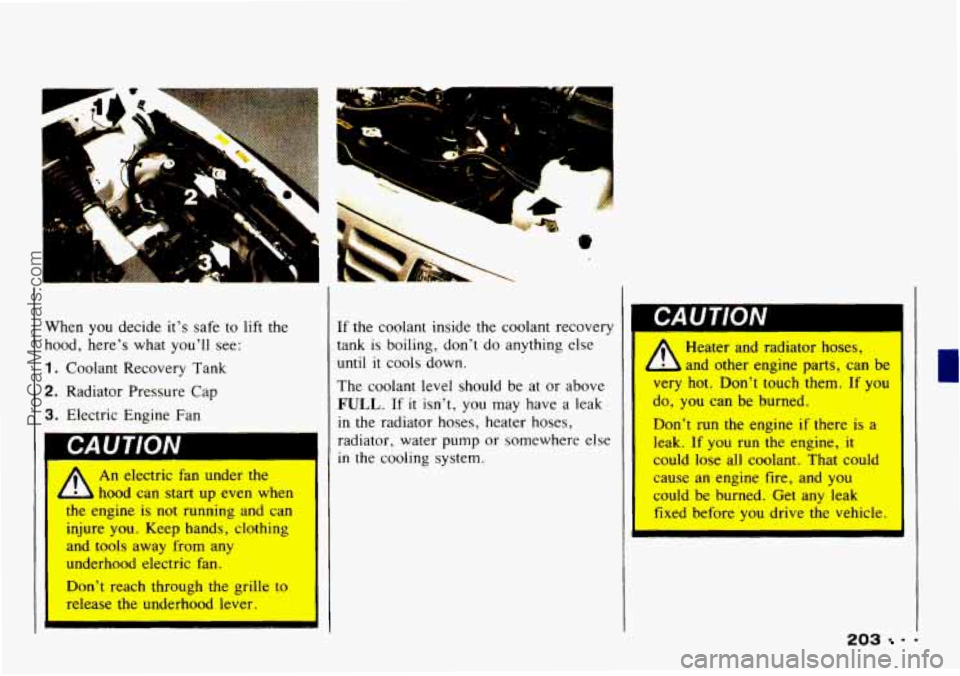
When you decide it’s safe to lift the
hood, here’s what you’ll see:
1. Coolant Recovery Tank
2. Radiator Pressure Cap
3. Electric Engine Fan
A An electric fan under the
hood can start up even when
thL @ne is not running and can
injure you. Keep hands, clothing
and tools away from any
underhood electric fan.
Don’t reach through the grille to
release the underhood lever.
- II E I L
If the coolant inside the coolant recovery
tank
is boiling, don’t do anything else
until it cools down.
The coolant level should be at
or above
FULL. If it isn’t, you may have a leak
in the radiator hoses, heater hoses,
radiator, water pump or somewhere else
in the cooling system.
unu I lVlV
Heater and radiator hoses,
1 L and other engine parts, can be
very hot. Don’t touch them. If you
do, you can be burned.
Don’t run the engine if there is a
leak. If you run the engine, it
could lose all coolant. That could
cause an engine fire, and you
could be burned. Get any leak
fixed before you drive the vehicle.
203 =
r
ProCarManuals.com
Page 206 of 339
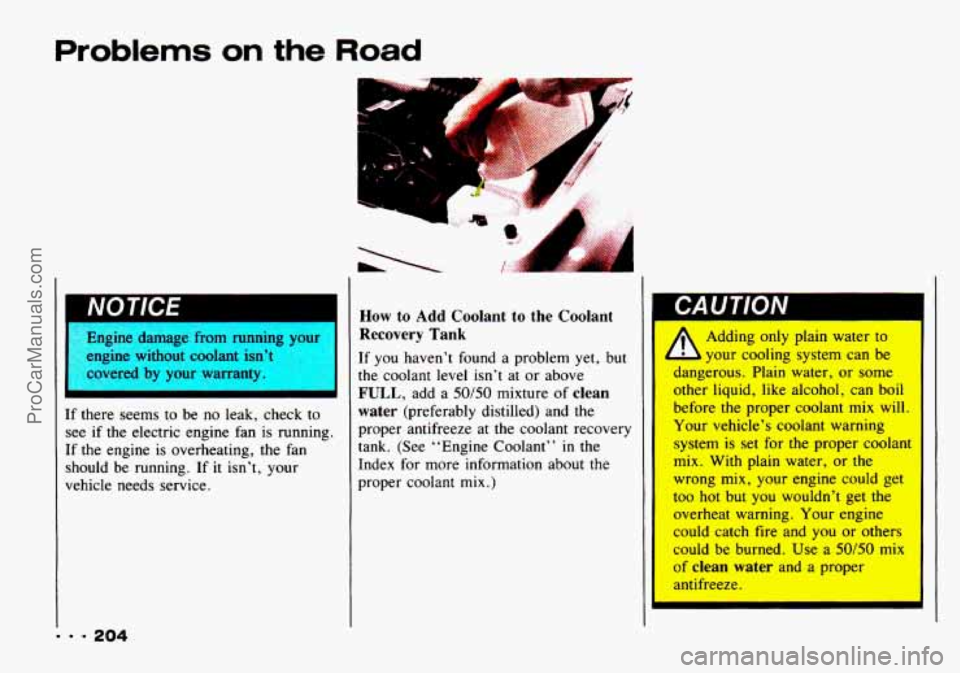
Problems on the Road
c
Engine damage from running yollr I
engine without coolant isn’t
covered by your warranty.
I
If there seems to be no leak, check to
see if the electric engine fan
is running.
If
the engine is overheating, the fan
should be running. If it isn’t, your
vehicle needs service.
How to Add Coolant to the Coolant
Recovery
Tank
If you haven’t found a problem yet, but
the coolant level isn’t at or above
FULL, add a 50/50 mixture of clean
water
(preferably distilled) and the
proper antifreeze at the coolant recovery
tank. (See “Engine Coolant”
in the
Index for more information about the
proper coolant mix.)
A Adding only plain water to
L your cooling system can be
dangerous. Plain water, or some
other liquid, like alcohol, can boil
before the proper coolant mix will.
Your vehicle’s coolant warning
system is set for the proper coolant
mix. With plain water, or the
wrong mix, your engine could get
too hot but you wouldn’t get the
overheat warning. Your engine
could catch fire and you or others
could be burned. Use a 50/50 mix
of clean water and a proper
antifreeze.
ProCarManuals.com
Page 207 of 339
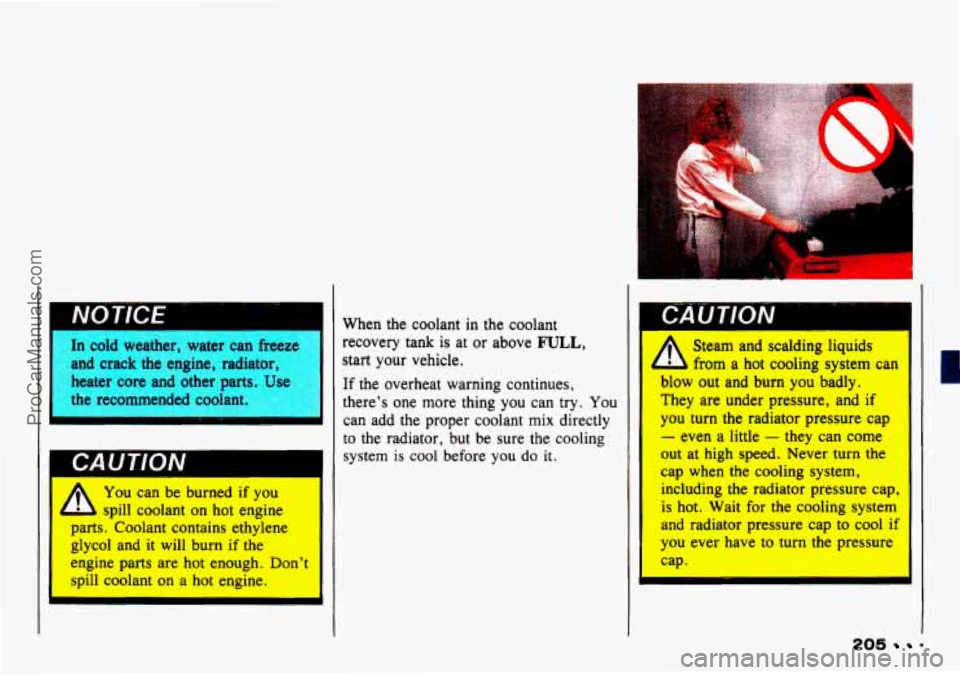
' In cold weather, water can freeze
and crack the engine, radiator,
\eater core and other parts.
Us
he recommended coolant.
I A You can be burned if you
- b spill coolant on hot engine
parts. Coolant contains ethylene
glycol and it
will burn if the
engine parts are hot enough. Don't
-?ill coolant on a hot engine. When the coolant
in the coolant
recovery tank is at or above
FULL,
start your vehicle.
If the overheat warning continues,
there's one more thing you can try. You
can add the proper coolant mix directly
to the radiator, but be sure the cooling
system
is cool before you do it.
I
I
Steam and scalding liquids
- b from a hot cooling system car
blow out and burn you badly. I
They are under pressure, and if
you turn the radiator pressure cap
- even a little - they can come
out at high speed. Never turn
the
cap when the cooling system,
including the radiator pressure cap,
is hot. Wait for the cooling system
and radiator pressure cap to cool
il
you ever have to turn the pressure
cap.
205
ProCarManuals.com
Page 208 of 339
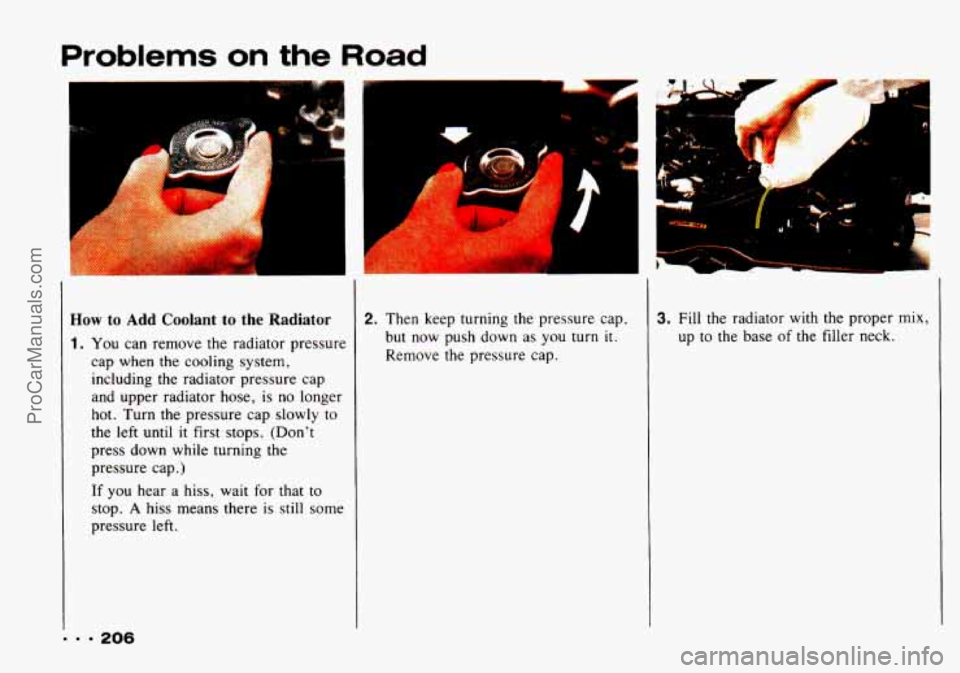
Problems on the Road
I
How to Add Coolant to the Radiator
1. You can remove the radiator pressure
cap when the cooling system,
including the radiator pressure cap
and upper radiator hose, is no longer
hot. Turn the pressure cap slowly
to
the left until it first stops. (Don't
press down while turning the
pressure cap.)
If you hear a hiss, wait for that to
stop. A hiss means there is still some
pressure
left.
2. Then keep turning the pressure cap,
but now push down as you turn
it.
Remove the pressure cap.
I A
3. Fill the radiator with the proper mix,
up
to the base of the filler neck.
ProCarManuals.com
Page 209 of 339
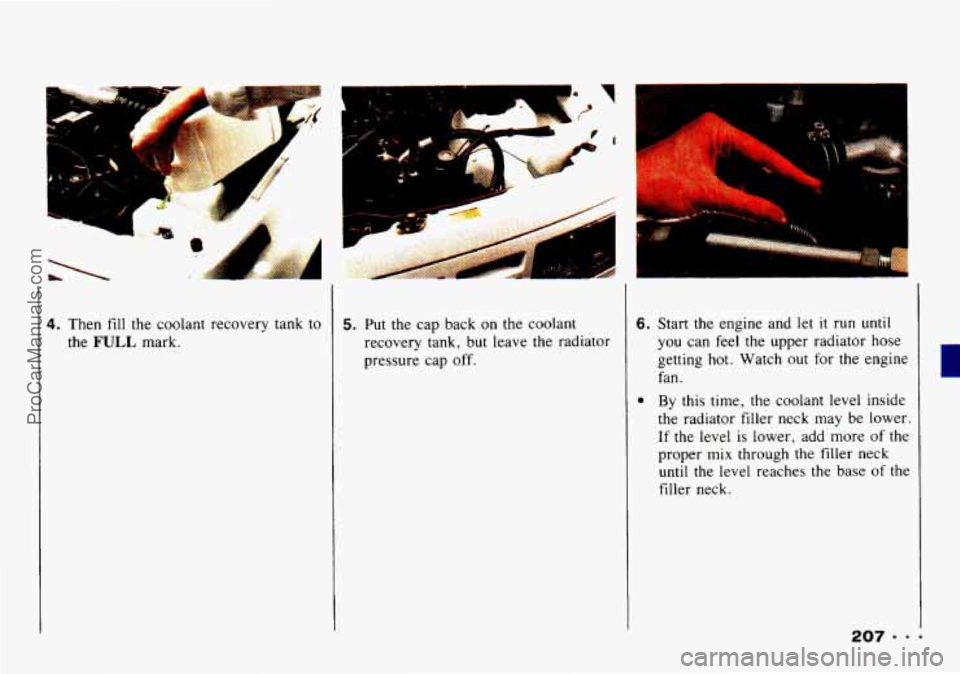
4. Then fill the coolant recovery tank to
the
FULL mark.
5. Put the cap back on the coolant
recovery tank, but leave the radiator
pressure cap
off.
6. Start the engine and let it run until
you can feel the upper radiator hose
getting
hot. Watch out for the engine
fan.
By this time, the coolant level inside
the radiator filler neck may be lower.
If the level is lower, add more of the
proper mix through the filler neck until the level reaches the base of the
filler neck.
r
ProCarManuals.com
Page 210 of 339
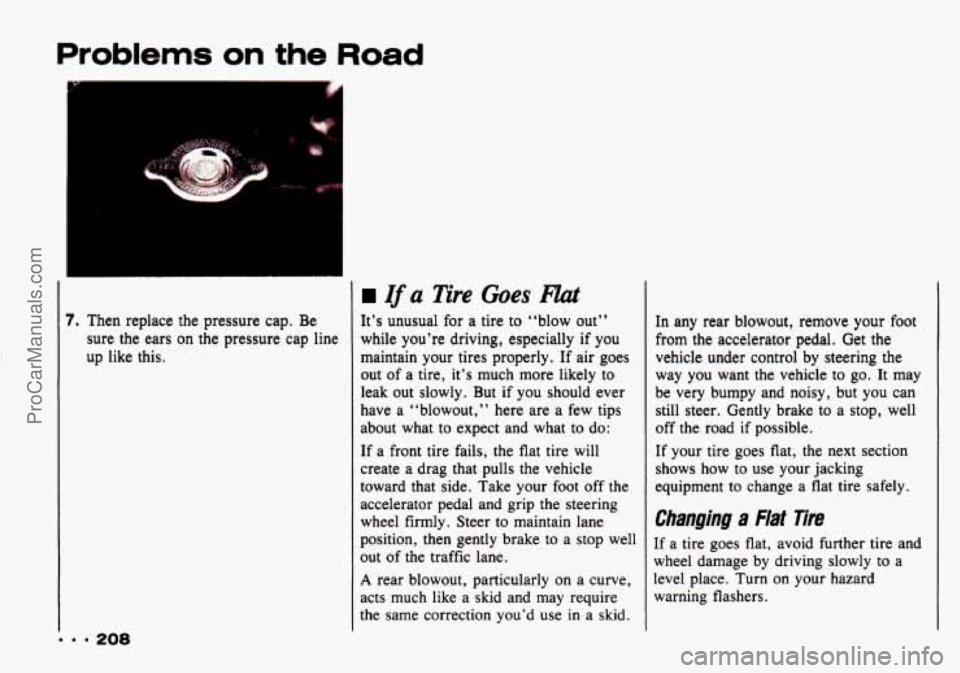
Problems on the Road
Zf a Tire Goes Hut
Then replace the pressure cap. Be
sure
the ears on the pressure cap line
up like
this.
9 208
It’s unusual for a tire to “blow out’’
while you’re driving, especially
if you
maintain your tires properly. If air goes
out of a tire, it’s much more likely to
leak out slowly. But if you should ever
have a “blowout,
” here are a few tips
about what to expect and what to do:
If a front tire fails, the flat tire will
create a drag that pulls the vehicle
toward that side. Take your foot off the
accelerator pedal and grip the steering
wheel firmly. Steer to maintain lane
position, then gently brake to a stop well
out of the traffic lane.
A rear blowout, particularly on a curve,
acts much like a skid and may require
the same correction you’d use
in a skid. In any
rear blowout, remove your
foot
from the accelerator pedal. Get the
vehicle under control by steering
the
way you want the vehicle to go. It may
be
very bumpy and noisy, but you can
still steer. Gently brake to a stop, well
off the road
if possible.
If your tire goes flat, the next section
shows how to use your jacking
equipment to change a flat tire safely.
ChanginQ a Flat lire
If a tire goes flat, avoid further tire and
wheel damage by driving slowly to a
level place. Turn
on your hazard
warning flashers.
..
ProCarManuals.com